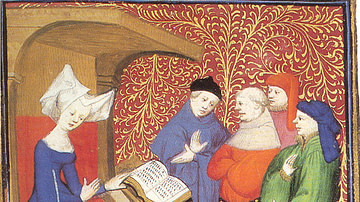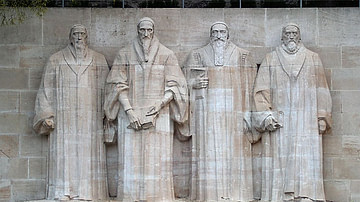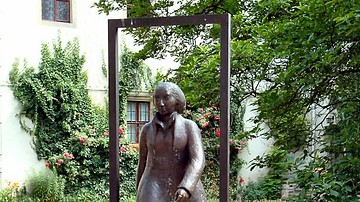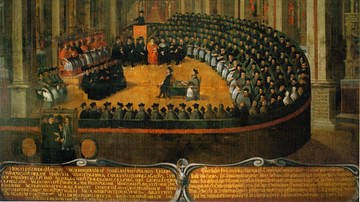The Book of the City of the Ladies (1405) by Christine de Pizan (l. 1364 - c. 1430) is considered by many scholars to be the first work of feminist literature, predating A Vindication of the Rights of Women (1792) by Mary Wollstonecraft by almost 400 years in advocating for the equality of women in society.
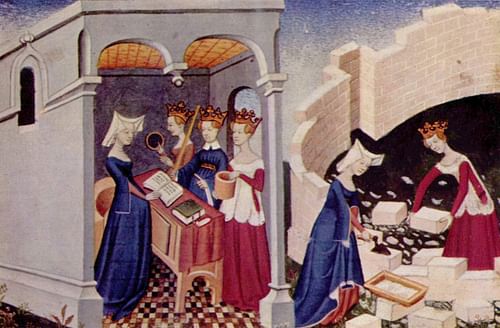
Women in the Middle Ages were regarded as second-class citizens, and their characters were regularly denigrated by male writers who either compared them to the Virgin Mary and found them wanting, or to Eve who was understood as corrupting humanity by tempting Adam to eat of the fruit in the Garden of Eden. These comparisons were encouraged by the teachings of the medieval Church, which maintained that Adam was deceived by Eve, and it was Eve who listened to the temptations of the serpent and first ate from the forbidden fruit. Women were, therefore, considered the 'weaker sex,' not only prone to the wiles of the devil but also apt to corrupt the most virtuous of men.
Pizan rejected this view in a number of her works, but most clearly in The Book of the City of the Ladies, an allegorical tale in which three women embodying Reason, Rectitude, and Justice visit the narrator (identified as the author) to help her build an intellectual and philosophical 'city of women' which will be a defense against the slanders of misogynistic writers and thinkers. The book drew on examples of great women from history, scripture, mythology, and literature to demonstrate how women were equal – and frequently superior – to men and deserved greater respect and wider opportunities.
Pizan clearly hoped that her works would influence the patriarchy to reconsider its view of women and embrace a vision of equality of the sexes on every level but was disappointed; just as Mary Wollstonecraft (l. 1759-1797) would be when A Vindication of the Rights of Women (often cited as the first feminist work) failed to change the views of the patriarchy. Even after the Protestant Reformation (1517-1648) challenged the tenets of the Catholic Church, women were still regarded as inferior to men up through Wollstonecraft's time and beyond.
Just as the lower class in Germany hoped for an elevation in their status after the Reformation began, women in general seem to have hoped for the same as evidenced by the writings of female Reformers such as Argula von Grumbach (l. 1490 to c. 1564) and Marie Dentière (l. c. 1495-1561). Women's lives did change after the Reformation, but the medieval view of them persisted. Even the great reformers such as Martin Luther (l. 1483-1546), Huldrych Zwingli (l. 1484-1531), and John Calvin (l. 1509-1564), who recognized their wives as equal partners in their work and lives, still believed that women were the 'weaker vessel' and had no place in public life among 'the affairs of men.' Pizan's vision of a metaphorical 'city of ladies' in which women were valued on par with men would not be realized until the 20th century and, even now, continues to be challenged and rejected, usually on religious grounds, just as it was in Pizan's own time.
Summary of the Text
The work begins with the narrator feeling despondent after reading the 13th-century poet Matheolus maintaining the sinfulness of women and how they corrupt and ruin men's lives, especially through marriage. While contemplating how Matheolus' views are found in many other works by learned scholars and clergy, she wonders how God, a master craftsman, could have made anything as terrible as a woman, and just then a light enters her room, revealing Lady Reason, Lady Rectitude, and Lady Justice. They assure her they mean her no harm but have only come to show her how wrong she is to believe the lies of men when, in her heart, she knows better and, as the narrator says, had "relied more on the judgment of others than on what I myself felt and knew" (I.1.1). The three ladies then begin to help her discard her false impressions and recognize her true worth and that of all women.
Lady Reason helps her build the outer walls of the allegorical city of ladies in refuting what male writers have written on women's evil nature and highlighting female virtues of courage, loyalty, and intellectual ability, citing numerous examples from well-known works, including the Bible. Once the defensive walls have been constructed, Lady Rectitude helps the narrator construct housing and public buildings in the city by further encouraging her to look to the examples of famous women. Lady Justice completes the city by focusing exclusively on female saints, clearly approved by God, who are praised by both men and women for their devotion and sacrifice, clearly rejecting the claim that women are, by nature, more sinful than men.
In the end, the narrator understands she has believed wrongly about women based on what men have said and written of them, as Lady Justice suggests that the best course for her, and all women, is "to cultivate virtue, to flee vice, to increase and multiply our City, and to rejoice and act well" (III.19.6). The admonition to "increase and multiply our City" suggests that women should reject the patriarchy's interpretation of the feminine and recognize what they know to be true of themselves.
The conclusion of the book echoes what Lady Reason says toward the beginning when she admonishes the narrator:
Come back to yourself, recover your senses, and do not trouble yourself anymore over such absurdities. For you know that any evil spoken of women so generally only hurts those who say it, not women themselves. (I.1.2)
The Status of Women
The section of the work often anthologized as The Status of Women is the opening scene of the book in which the narrator falls into despair and is introduced to the three ladies. Lady Reason's speech concerning what men have said about women, as contrasted with women's true nature, makes up most of the text, only a part of which is given below. The text is taken from A Reformation Reader: Primary Texts with Introductions edited by Denis R. Janz, pp. 14-17, cross-referenced and supplemented at points by Pizan's The Book of the City of Ladies translated by Earl Jeffrey Richards. Some lines have been omitted to conserve space and are indicated by ellipses.
One day as I was sitting alone in my study surrounded by books on all kinds of subjects, devoting myself to literary studies, my usual habit, my mind dwelt at length on the weighty opinions of various authors whom I had studied for a long time. I looked up from my book, having decided to leave such subtle questions in peace and to relax by reading some light poetry. With this in mind, I searched for some small book…When I held it open and saw from its title page that it was by Matheolus, I smiled, for though I had never seen it before, I had often heard that, like other books, it discussed respect for women…I started to read it and went on for a little while. Because the subject seemed to me not very pleasant for people who do not enjoy lies, and of no use in developing virtue or manners, I put it down in order to turn my attention to more elevated and useful study.
But just the sight of this book, even though it was of no authority, made me wonder how it happened that so many different men – and learned men among them – have been and are so inclined to express both in speaking and in their treatises and writings so many wicked insults about women and their behavior…They all concur in one conclusion: that the behavior of women is inclined to and full of every vice. Thinking deeply about these matters, I began to examine my character and conduct as a natural woman and, similarly, I considered other women whose company I frequently kept, princesses, great ladies, women of the middle and lower class who had graciously told me of their most private and intimate thoughts, hoping that I could judge impartially and in good conscience whether the testimony of so many notable men could be true.
To the best of my knowledge, no matter how long I confronted or dissected the problem, I could not see or realize how their claims could be true when compared to the natural behavior and character of women. Yet I still argued vehemently against women, saying that it would be impossible that so many famous men – such solemn scholars, possessed of such deep and great understanding, so clear-sighted in all things, as it seemed – could have spoken falsely on so many occasions that I could hardly find a book on morals where, even before I had read it in its entirety, I did not find several chapters or certain sections attacking women, no matter who the author was…And so I relied more on the judgment of others than on what I myself felt and knew…
And finally, I decided that God formed a vile creature when He made woman, and I wondered how such a worthy artisan could have deigned to make such an abominable work which, from what they say, is the vessel as well as the refuge and abode of every evil and vice. As I was thinking this, a great unhappiness and sadness welled up in my heart, for I detested myself and the entire feminine sex, as though we were monstrosities in nature…So occupied with these painful thoughts, my head bowed in shame, my eyes filled with tears, leaning on the pommel of my chair’s armrest, I suddenly saw a ray of light fall on my lap, as though it were the sun…And as I lifted my head to see where this light was coming from, I saw three crowned ladies standing before me, and the splendor of their bright faces shone on me and throughout the entire room…Fearing that some phantom had come to tempt me, and filled with great fright, I made the Sign of the Cross on my forehead.
Then she who was the first of the three smiled and began to speak, "Dear daughter, do not be afraid, for we have not come here to harm or trouble you but to console you, for we have taken pity on your distress, and we have come to bring you out of the ignorance which so blinds your own intellect that you shun what you know for a certainty and believe what you do not know or see or recognize except by virtue of many strange opinions…Sweet friend, don’t you see the overweening madness, the irrational blindness which prompt such observations? Is Nature, the chambermaid of God, a greater mistress than her master, almighty God from whom comes such authority, who, when He willed, took the form of man and woman from His thought when it came to His holy will to form Adam from the mud of the ground in the field of Damascus and, once created, brought him into the Terrestrial Paradise which was and is the most worthy place in this world here below? There Adam slept, and God formed the body of woman from one of his ribs, signifying that she should stand at his side as a companion and never lie at his feet like a slave, and also that he should love her as his own flesh. If the Supreme Craftsman was not ashamed to create and form the feminine body, would Nature then have been ashamed? It is the height of folly to say this! Indeed, how was she formed? She was created in the image of God. But some men are foolish enough to think, when they hear that God made man in His image, that this refers to the material body. This was not the case, for God had not yet taken a human body. The soul is meant, the intellectual spirit which lasts eternally just like the Deity. God created the soul and placed wholly similar souls, equally good and noble, in feminine and in masculine bodies…" [Lady Reason then gives examples of many great and noble women].
After hearing these things, I replied, "My lady, truly has God revealed great wonders in the strength of these women whom you describe. But please enlighten me again, whether it has ever pleased this God, who has bestowed so many favors on women, to honor the feminine sex with the privilege of the virtue of high understanding and great learning, and whether women ever have a clever enough mind for this. I wish very much to know this because men maintain that the mind of women can learn only a little."
She answered, "My daughter, since I told you before, you know quite well that the opposite of their opinion is true, and to show you this even more clearly, I will give you proof through examples. I tell you again – if it were customary to send daughters to school like sons, and if they were then taught the natural sciences, they would learn as thoroughly and understand the subtleties of all the arts and sciences as well as sons. And by chance there happen to be such women…Do you know why women know less? Without the slightest doubt, it is because they are not involved in many different things, but stay at home, where it is enough for them to run the household, and there is nothing which so instructs a reasonable creature as the exercise and experience of many different things…
It is wrong to say that the majority of women are not good. This is well proven from what I have told you before about the experiences evident every day in their prayers and charitable acts and virtues and from the fact that the great horrors and evils perpetrated in the world do not come about because of them. But what a surprise that all women are not good! In the entire city of Nineveh, which was so large, not a single good man could be found when Jonah the prophet went there on behalf of our Lord to destroy it unless it turned away from its evil. It was even worse in the city of Sodom, as was obvious when fire from Heaven destroyed it after Lot's departure. Moreover, note that in the company of Jesus Christ, where there were only twelve men, there was still one very bad man among them. And men dare to say that all women must be good and that one should stone those who are not! I would simply ask them to look at themselves and then let him who is without sin cast the first stone! Indeed, I maintain that when men are perfect, women will follow their example."
Conclusion
Although Lady Reason, Lady Rectitude, and Lady Justice eloquently argued for women's equality throughout Pizan's work, their speeches had little effect on men's attitudes toward women. Even after many of the Church's teachings were rejected during the Protestant Reformation, the concept of women as inherently sinful was retained. Influential women of the Reformation such as Argula von Grumbach and, especially, the reformer Marie Dentière argued against this view, just as Pizan had done, but the established view of the inferiority of women did not change.
Jeanne d'Albret (l. 1528-1572) proved herself as worthy a monarch as any man and Olympia Fulvia Morata (l. 1526-1555) as able a scholar as any writing at her time. These women, and many others, lived Pizan's vision of a 'city of women' who understood their worth and charted their own course, but the patriarchal view of women as sinful and corrupt continued to be advanced.
One work epitomizing this view is The First Blast of the Trumpet Against the Monstrous Regiment of Women (1558) by the Scottish Reformer John Knox (l. c. 1514-1572), which argued primarily against female rulers but, by extension, the concept of equality for all women. Knox, who was rabidly anti-Catholic, still repeated the old teaching that Eve had rebelled and so women had to be held subject to men to control their baser instincts and try to bolster their inherent weaknesses. Other male reformers were much kinder to women than Knox, but even Calvin, who valued the opinion of women, ruled against female ministers, citing the biblical text of I Timothy 2:12, and distanced himself from Marie Dentière as he felt she was too outspoken.
Pizan's works, the polar opposite of those by Knox, were still popular reading among upper-class women in the early 1500s when, for unknown reasons, they fell out of print and were only rediscovered in the 19th century. Even if The Book of the City of the Ladies was available during the Reformation, however, it is unlikely it would have had any more effect than it did when first published as it contradicted the established Christian narrative on the nature of women, and whether Protestant or Catholic, that would not be challenged successfully until the late 19th and early 20th century and continues to be today.


